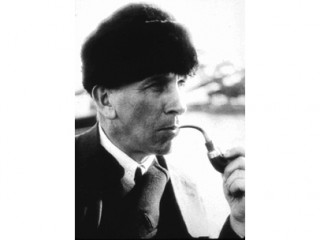
Alfred Wegener biography
Date of birth : 1880-11-01
Date of death : 1930-11-01
Birthplace : Berlin, Germany
Nationality : German
Category : Famous Figures
Last modified : 2010-11-21
Credited as : Meteorologist and explorer, geophysicist, known for the theory of continental drift
The German meteorologist, Arctic explorer and geophysicist Alfred Lothar Wegener is remembered for his theory of continental drift.
Alfred Wegener son of an Evangelical preacher, was born in Berlin on Nov. 1, 1880. He attended university at Heidelberg, Innsbruck, and Berlin. He became interested in arctic climatology and joined the 1906-1908 Danish expedition to Greenland as meteorologist. He returned there in 1912-1913 and, wintering on a high glacier, completed studies begun on his first visit.
In 1908 Wegener settled at Marburg, lecturing there with enviable clarity on meteorology and astronomy. The next years were perhaps his most fruitful: he wrote up his Greenland material; produced his Thermodynamik der Atmosphäre (1911), a standard textbook which ran through several editions; and conceived his idea of continental drift. He saw active service in World War I.
Wegener was a scientific civil servant at the Meteorological Department of the Deutsche Seewarte in Hamburg (1919-1924) and professor of meteorology and geophysics at the University of Graz (1924-1930). There he drew together aspects of subjects hitherto considered disparate while planning for a two-winter expedition to Greenland, scheduled to begin in 1930. He made a preliminary visit in 1929. Early in November 1930, in attempting to cross Greenland from an ice-cap camp to the Kamarujuk base on the west coast, he lost his life.
Most of Wegener's life was spent in conventional meteorology, and his contributions both there and in polar exploration have been recognized. But Wegener is most widely remembered for his theory of continental drift. In 1910 he was struck by the congruity of the east and west Atlantic shorelines. This, coupled with his fortuitous reading of evidence indicative of a land bridge from Brazil to Africa, led him to examine the geologic and paleoclimatologic evidence for his rapidly burgeoning continental drift theory. He suggested that until Mesozoic times the light material of the earth's crust formed one continental block floating on the dense core, that relative movement has since occurred, and that the geographic poles have wandered. These views he published in 1912 and expanded into book form as Die Entstehung der Kontinente und Ozeane (1915; The Origins of Continents and Oceans, 1924). The theory first received adverse criticism and then interested discussion. Many objections were overcome in later editions of the work, but in seeking a mechanism for the movements, Wegener failed. Thus the theory was long discounted. Recent work based on new information has led to a general acceptance of the concept.
Wegener's biography by his daughter, Else Wegener, Alfred Wegener (1960), is in German. S.K. Runcorn, ed., Continental Drift (1962), includes a memoir on Wegener. Background on Wegener is in Johannes Georgi, Mid Ice: The Story of the Wegener Expedition to Greenland (trans. 1934).
Schwarzbach, Martin, Alfred Wegener, the father of continental drift, Madison, Wis.: Science Tech, 1986.
















